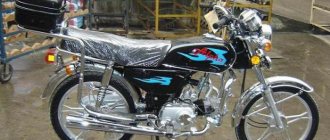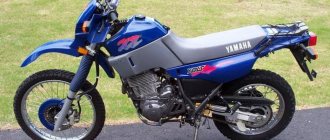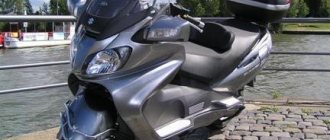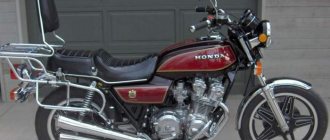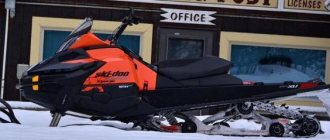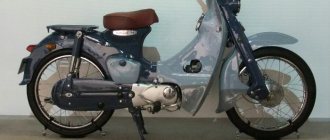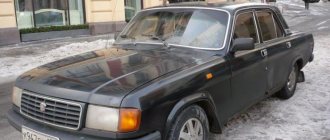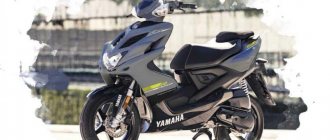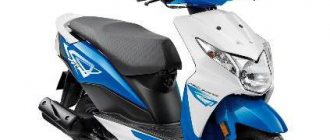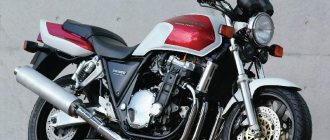Design
When developing the station wagon, Soviet engineers were guided by the following principle: to create a new car with maximum consumer effect and minimal production costs. That is why the model 2105, which debuted three years ago (in 1979), was taken as a basis. Externally, these cars are very similar. So, in front there is the same black plastic grille, rectangular headlights and a large metal bumper without “fangs”. Thus, only the rear part has undergone changes. The engineers simply lengthened the roof and modified the “fifth” door. Even the rear lights remained the same (but were now located vertically). It must be said that the rigidity of the roof was insufficient for transporting heavy loads. The strength of the roof was less than on the base “five”. However, many overloaded the “four” and then had body defects.
The VAZ-21043 went on sale in several colors:
- White.
- Blue.
- Green.
- Red.
This car has never been painted metallic.
Modifications
- VAZ-2104 - VAZ-2105 engine, 1.3 liters, carburetor, with a 4-speed gearbox, base model.
- VAZ-21041 - VAZ-2101 engine, 1.2 liters, carburetor with 4-speed. Checkpoint. Not serially produced.
- VAZ-21042 - VAZ-2103 engine, 1.5 liters, right-hand drive.
- VAZ-21043 - VAZ-2103 engine, 1.5 liters, carburetor with 4- or 5-speed. Gearbox, in versions with electrical equipment and interior from the VAZ-2107. (In 2003, some cars were produced with interior 2106)
- VAZ-21044 - VAZ-2107 engine, 1.7 liters, single injection, 5-speed. Gearbox, export model.
- VAZ-21045 - VAZ-2107 engine, 1.8 liters, single injection, 5-speed. Gearbox, export model. Not serially produced.
- VAZ-21045D - VAZ-341 engine, 1.5 liters, diesel, 5-speed. Checkpoint.
- VAZ-21047 - VAZ-2103 engine, 1.5 liters, right-hand drive, carburetor, 5-speed. Checkpoint.
- VAZ-21048 - VAZ-343 engine, 1.77 liters, diesel, 5-speed. Checkpoint.
- VAZ-21041i - VAZ-21067 engine 1.6 liter injector, 5-speed gearbox, interior and electrical equipment of VAZ-2107, front seats from IZH-2126.
- VAZ-21041 VF - design of the VAZ-2107 radiator, VAZ-2103 engine 1.5 liter injector, 5-speed gearbox, interior and electrical equipment of the VAZ-2107, front seats from IZH-2126.
Body, paint and corrosion
This is a separate topic for discussion. There was practically no corrosion protection on the car, which is why the metal rusted very quickly. The paint was flying off, and pockets of corrosion instantly appeared in bare areas. It must be said that the metal itself was quite thin. Very often this car had to be treated with Movil and anti-gravel in order to somehow slow down the rotting process. It is very difficult to find a VAZ-21043 in its original paint. Many specimens were painted. And since the Quartet was a working machine, no one bothered with the quality of the work - many simply spray-painted the car.
Salon
The interior design here is the same as on the “five”. A key feature of the VAZ-21043 was the presence of more comfortable seats from the “seven”. Otherwise, the car was no different from other Zhiguli cars. The driver is provided with an ascetic instrument panel and a non-adjustable four-spoke steering wheel. By the way, in the first versions the instrument panel did not have a tachometer. But it was possible to control the speed without it - the engine could easily be heard in the cabin. In addition, there were outrages about the torpedo. She constantly creaked on bumps. Desperate owners completely dismantled the interior and covered it with numerous sheets of sound insulation. There was an effect, but it was still not possible to completely get rid of the noise.
The car seats do not have good lumbar support. Over time, the chairs sank and tore. Because of this, many cars were fitted with covers. And some even installed seats from foreign cars.
Diesel modification
In 1999, a modification of the VAZ 21045
with a VAZ-341 diesel engine produced by Barnaultransmash with a volume of 1.52 liters and a Bosch injection pump.
Since 2005, it was planned to install a more powerful version of a 1.8-liter diesel engine (modification of the VAZ-21048
), but these plans remained unrealized[4].
The diesel modification was distinguished by a significantly higher cost and lower power of the power plant, despite the fact that in these years diesel fuel was noticeably cheaper than gasoline, the economic feasibility of purchasing this version was in doubt K: Wikipedia: Articles without sources (type: not specified)[ source not 2100 days specified
].
In 2003, production of the VAZ-21045 was discontinued; the remaining unspecified diesel engines in the amount of 500 pieces were equipped with a batch of the new modification VAZ-21055[5].
Differences from the petrol version
- additional sound insulation of the engine compartment;
- reinforced front suspension springs;
- main pair 3.9 (petrol 4.1);
- exhaust pipe wrapped in a loop (to avoid contamination of the right lamp with soot);
- on the control panel: the presence of a fuel filter heating key, as well as a glow plug heating indicator[6].
Technical characteristics of VAZ-21043
Like the rest of the Zhiguli, this model was equipped with four-cylinder eight-valve engines, which were located longitudinally relative to the body. Initially, the “four” was equipped with a carburetor engine from the “troika”. It was a one and a half liter engine with a power of 71 hp. With. The gearbox was four-speed. However, later the car began to be equipped with a five-speed gearbox.
In addition, there was an injection engine. In the 2000s, the VAZ-21043 was equipped with an engine with distributed fuel injection. But the technical specifications have not changed. With the same volume, the car developed the same power. The torque has changed. If the car developed 104 Nm on the carburetor, then thanks to the injector this figure increased to 110.
What are the dynamic characteristics of the VAZ-21043? As reviews note, this car is not at all designed for racing. The empty “four” accelerated to hundreds in 17 seconds. The maximum speed was 142 kilometers per hour. But some versions were equipped with a more “traction” gearbox, which is why the car accelerated to 137 kilometers per hour. However, it must be said that speeds over 80 km/h are no longer comfortable for this car. The fuel consumption of the car is about ten liters per hundred. Some owners install HBO on the “four” to save on fuel. By the way, the Zhiguli engine “digests” gas perfectly. Consumption does not increase, but traction remains the same.
If we talk about problems, this engine had the usual problems for Zhiguli. These are increased oil consumption, short camshaft life, oil seal leaks, and the need to adjust valve clearances every 7 thousand kilometers.
The box is also not without problems. Thus, owners note increased operating noise due to wear of the shaft bearings. The clutch becomes unusable at about 40 thousand. Also, synchronizers wear out over the years. As a result, the gears are engaged with a characteristic crunch.
Development of the idea of station wagons at AvtoVAZ
Having launched the VAZ-2104 into production in 1984, AvtoVAZ designers did not remove the drawing paper from their drawing boards. They continued to develop the idea of a station wagon, developing variations of the flagship modification of the VAZ 21043. Over the years of production of the 43rd model, they were tested:
- 21048 - diesel VAZ-343, 1.77 liters;
- 21041i - 1.6-liter VAZ-21067 injection engine;
- 21041 VF - injection VAZ-2103 1.5 liters.
These modifications were not produced en masse, but all these years they kept domestic designers in relative shape.
Having exhausted the potential of the body in twenty years of production, and the potential of the engine in thirty years, modification 21043 left the production line. But the objective advantages of station wagons have not gone away. New groups of layout adherents have emerged. These are city dwellers with large families and young people who value the ability to transport large sports equipment.
Station wagons are strengthening their position in the market. And AvtoVAZ is the leader in this. Recently, the Lada Largus station wagon has become popular. This car, like the VAZ 2104 in its time, has a European prototype - the Dacia Logan MCV model produced by Renaul-Nissan. Lada Largus is available in both 5-seater and 7-seater versions, which expands its capabilities. Largus engines have been tested on Renault Logan and have excellent technical characteristics. The spare wheel under the bottom reduces the ground clearance, but the promising Lada Largus Cross does not have this drawback.
Domestic heirs of the legendary VAZ 21043 station wagon are still leaders in our market, now competing not only with the two-volume Moskvich-2141, but also with the KIA Ceed and Ford Focus station wagons.
| LADA 2104 | |
| Total information | |
| Manufacturer | VAZ |
| Years of production | 1984—2012 [1] |
| Assembly | VAZ (Tolyatti, USSR) AvtoVAZ (Tolyatti, Russia) IzhAvto (Izhevsk, Russia) RosLada (Syzran, Russia) LuAZ (Lutsk, Ukraine) KrASZ (Kremenchug, Ukraine) AntoRus (Kherson, Ukraine) Suzuki Egypt (Giza, Egypt) |
| Class | small group III |
| Other designations | VAZ-2104 "Zhiguli", Lada Estate, Lada Riva Break, Lada Nova Combi |
| Design | |
| Body type | 5-door station wagon (5-seater) |
| Platform | Fiat 124 |
| Layout | front-engine, rear-wheel drive |
| Wheel formula | 4 × 2 |
| Engine | |
| VAZ-2103 | |
| Manufacturer | AvtoVAZ |
| Brand | VAZ-2103 |
| Type | gasoline (AI-92) carburetor |
| Volume | 1,458 cm 3 |
| Maximum power | 52.5 kW (71 hp), at 5600 rpm |
| Maximum torque | 104 Nm, at 3400 rpm |
| Configuration | in-line, 4-cylinder. |
| Cylinders | 4 |
| Valves | 8 |
| Combined fuel consumption | 9,9 |
| Fuel consumption in the urban cycle | 9,8 |
| Fuel consumption on the highway | 7,0 |
| Environmental standards | Euro 2 |
| Compression ratio | 8,5 |
| VAZ-2105 | |
| Manufacturer | AvtoVAZ |
| Brand | VAZ-2105 |
| Type | gasoline (AI-92) carburetor |
| Volume | 1,290 cm 3 |
| Maximum power | 46.80 kW (64 hp), at 5600 rpm |
| Maximum torque | 92.0 Nm, at 3400 rpm |
| Configuration | in-line, 4-cylinder. |
| Cylinders | 4 |
| Valves | 8 |
| Combined fuel consumption | 9,2 |
| Fuel consumption in the urban cycle | 10 |
| Fuel consumption on the highway | 6,9 |
| Environmental standards | Euro 2 |
| Compression ratio | 8,5 |
| VAZ-21067 | |
| Manufacturer | AvtoVAZ |
| Brand | VAZ-21067 |
| Type | gasoline (AI-92) distributed injection |
| Volume | 1569 cm 3 |
| Maximum power | 55 kW (75 hp), at 5000 rpm |
| Maximum torque | 116.0 Nm, at 3400 rpm |
| Configuration | in-line, 4-cylinder. |
| Cylinders | 4 |
| Valves | 8 |
| Combined fuel consumption | 8,5 |
| Fuel consumption in the urban cycle | 11,3 |
| Fuel consumption on the highway | 6,9 |
| Environmental standards | Euro 2 |
| Compression ratio | 8,5 |
Chassis
The suspension here is completely identical to the “five”. So, the front has an independent suspension with hydraulic shock absorbers and transverse swing arms. There was a bridge at the back and there were rods (four longitudinal and one transverse). Brakes are discs at the front and drums at the rear. As reviews note, this car lacks brakes, especially if it is loaded with 200-300 kilograms. There are also complaints about the steering. The car has poor road holding and is not maneuverable.
Among the advantages of the suspension is its softness. However, this does not mean that you can safely “fly” through the pits. The suspension doesn't like sharp impacts. Because of this, the shock absorbers leak and the lower arms are deformed. Among the weak points of the Zhiguli suspension, it is worth noting the ball joints. These are supports and tips. They become unusable very quickly. Wheel bearings also have a short lifespan. Another drawback is the sound of the suspension. Even if the chassis is in good working order, various knocks can be heard inside. It's alarming at first, but you can get used to it.
Price
This is perhaps the most affordable station wagon available on the secondary market. The cost of the “four” is from 20 to 60 thousand rubles. The mileage of all cars is different, but since the odometer is only calculated up to 100 thousand, it is difficult to find out the exact mileage. And since it is predominantly a workhorse, it is more difficult to find a “four” in good condition than the same “seven” or “five”.
